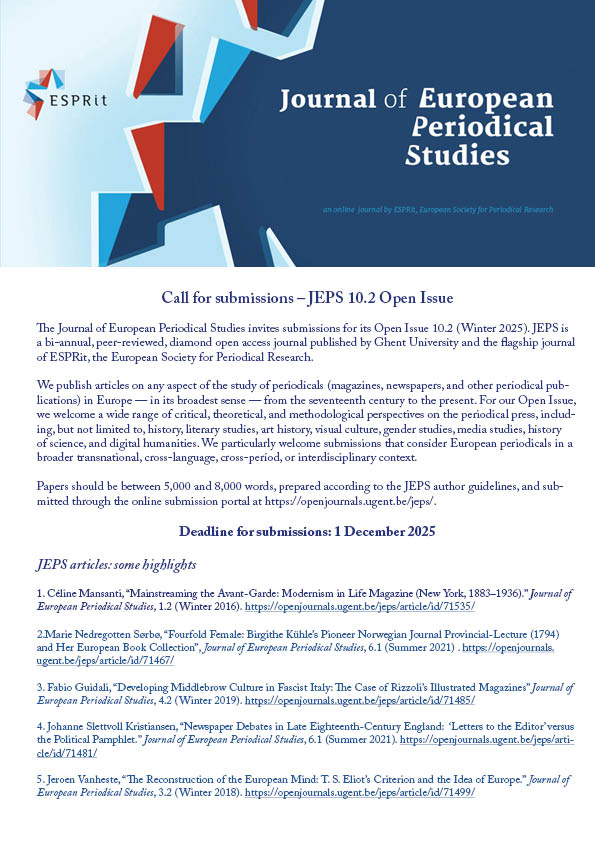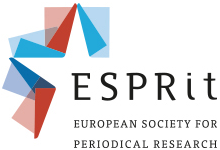Call for submissions – JEPS 10.2 Open Issue

Thank you for your registration
Thank you for your registration! The organisers of the ESPRit conference will send you further information via e-mail.
ESPRit online seminar with Yelizaveta Raykhlina and Effrosyni Zacharatou
ESPRit online seminars, Autumn 2021: ‘Crossover influences and local identities of the popular illustrated periodicals of the nineteenth and twentieth centuries’
Autumn series 2021, Session 3 - December 10, 3PM CET:
1) Yelizaveta Raykhlina (New York University), From Paris to the Russian Provinces: Russian-language Fashion Magazines of the late 1830s and 1840s as Domains of Cultural Adaptation and Women’s Entrepreneurship”.
This presentation explores the role of the Russian-language illustrated fashion press as a forum for translating and adapting French fashion for Russian readers during the late 1830s and through the 1840s. These years serve as a turning point in the development of the Russian press, as they mark the emergence of the first Russian fashion magazines that were founded by women entrepreneurs. Coming from non-noble origins, these women publisher-editors (Elizaveta Safonova and Mariia Koshelevskaia) had the unusual role of reporting on French fashion to Moscow and Petersburg high society and, importantly, on French and Russian fashion to provincial Russian noblewomen. The purpose of their magazines was not to imitate foreign styles, but to adapt them to Russian needs; in the process, these fashion magazines joined a broader conversation taking place across the Russian periodical press about defining “Russian” culture. The long print run of these magazines is a testament to their editors’ successful strategies, made all the more impressive at a time when new Russian periodicals folded within a year of their launch. While the Russian-language press was always in conversation with the European presses of the time (particularly French, German, and English), current scholarship tends to treat Russian periodicals separately. This presentation aims to stimulate a conversation about integrating Russian press history into a broader European context."
2) Effrosyni Zacharatou (Athens School of Fine Arts), From Europe to Greece: The illustrated magazine as a distinct form
The proposed paper, based on my doctoral research, considers the ways in which Greek illustrated magazines emerged in relation to their relationship to the broader, and older, currents of European periodical publishing. The adoption of such a comparative approach is necessary given the absence of any monograph, or indeed any systematic research, on the Greek illustrated magazine, despite the fact that it was a major cultural phenomenon, and an integral part of the visual culture of Greece. The paper begins with an analysis of the circumstances and conditions that led to the emergence of the illustrated magazine in Greece at the beginning of the 19th century. Then it briefly considers a number of key issues, including the following:
- the development in Greece of printing technology, especially lithography and engraving,
- the impact of industrialisation and transport,
- the growth of markets and early capitalist social relations,
- changes in education, culture and ideology, particularly the influence of Saint- Simonianism, social reform movements, the growth of literacy and the rise of the bourgeoisie, along with notions of egalitarianism, the democratization of art, and the emergence of nationalism.
The remainder of the paper considers the ‘external’ characteristics of readership, form, format and pagination, as well as such ‘internal’ characteristics as content (editorial, advertising, image quantity and quality, organic relation between language and image) drawn from a limited number of examples of Greek illustrated magazines. In conclusion, the paper speculates on the relationship between the growth of such periodicals in Greece and the making, at broadly the same time, of an urban middle-class from which it drew its producers, advertisers and readers.
Registration failed
Unfortunately, the registration process did not succeed.
Please try again or contact us at This email address is being protected from spambots. You need JavaScript enabled to view it..
ESPRit online seminar with Susann Liebich and Felix Larkin
ESPRit online seminars, Autumn 2021: ‘Crossover influences and local identities of the popular illustrated periodicals of the nineteenth and twentieth centuries’
Autumn series 2021, Session 2 - November 19, 3PM CET:
1) Susann Liebich (Heidelberg University), A New Zealand ‘quality magazine’: The Monocle, 1937-1939
In May 1937, a new magazine appeared in the New Zealand print market place: The Monocle, using the sub-title ‘New Zealand’s quality magazine’ was the country’s first dedicated men’s magazine; and a sign of maturity and confidence of its publishing scene. As is true for periodicals published in New Zealand in the first half of the twentieth century more generally, there has been little scholarly attention paid to The Monocle. This paper considers the publication of this magazine as an attempt to articulate a local version of transnational magazine culture on the edges, or outside of, the cosmopolitan and global centres of the English-speaking publishing world. Modelled clearly on overseas counterparts, the magazine offered a New Zealand specific version of middle-brow and middle-class modernity, first explicitly directed at men, then, soon after, addressing a mixed gender readership. The magazine was a relatively short-lived venture, folding after two years. Nevertheless, as a publishing experiment, The Monocle was a trailblazer in a print market still largely dominated by imported publications. This paper introduces The Monocle, reflects on possible reasons for its demise, and considers its role and legacy within a transnationally shaped New Zealand magazine market.
2) Felix Larkin, Periodicals and Journalism in Twentieth-Century Ireland
My paper will survey the Irish periodical press over the course of the twentieth century with a particular focus on its contribution to the development of journalism in Ireland. The research that has been done to date on Irish periodicals has tended to concentrate on the journal as literary miscellany rather than as a vehicle for news and commentary.
From the early 1900s onwards journals advocating an Irish-Ireland, a republican Ireland, a workers’ republic, a Catholic Ireland, as well as journals promoting the Irish language, the co-operative movement and the rights of women began to appear. After independence, a new breed of journal critiquing the kind of society that was emerging in the new state began to flourish. Some journals were unambiguously organs of dissent; others were organs of important minority communities that would not otherwise have had a voice in Irish media – for example, women, the young, the gay community, religious interests and the Irish-Ireland movement.
In the latter forty years of the century, the most prominent journals were those that concentrated on current affairs, promoted investigative journalism and exposed the often opaque intercourse between the worlds of business and politics. These journals helped shape the thinking that led to a more open Irish society from the late-1960s onwards.
By reference to the periodical landscape, the paper will draw on themes of continuity and discontinuity in Irish society in the twentieth century, the notion of what a free press actually meant at different times, the relationship between periodicals and the public sphere, and the political economy of periodical publishing. It will also raise the pertinent question of the future for periodicals in the digital age.
